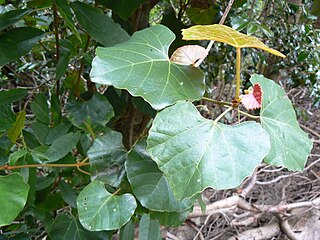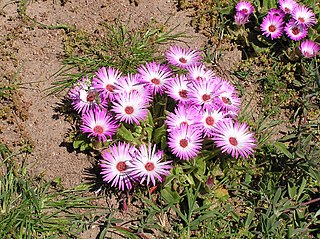
Podocarpus latifolius is a large evergreen tree up to 35 m high and 3 m trunk diameter, in the conifer family Podocarpaceae; it is the type species of the genus Podocarpus.

Muntingia is a genus of plants in the family Muntingiaceae, comprising only one species, Muntingia calabura, and was named in honour of Abraham Munting. It is native to the Neotropics, from Mexico south to Bolivia and Argentina, with edible fruit, and has been widely introduced in other tropical areas.

Dracaena fragrans, is a flowering plant species that is native throughout tropical Africa, from Sudan south to Mozambique, west to Côte d'Ivoire and southwest to Angola, growing in upland regions at 600–2,250 m (1,970–7,380 ft) altitude. It is also known as striped dracaena, compact dracaena, and corn plant.

Phaenocoma is a genus of South African plants in the tribe Gnaphalieae within the family Asteraceae. The name is derived from the Greek roots φαίνω and κόμη (hair), which refer to dry and shiny involucral bracts.

Renosterveld is a term used for one of the major plant communities and vegetation types of the Cape Floristic Region which is located in southwestern and southeastern South Africa, in southernmost Africa. It is an ecoregion of the Mediterranean forests, woodlands, and scrub biome.

Kumara plicatilis, formerly Aloe plicatilis, the fan-aloe, is a succulent plant endemic to a few mountains in the Fynbos ecoregion, of the Western Cape in South Africa. The plant has an unusual and striking fan-like arrangement of its leaves. It may grow as a large multistemmed shrub or as a small tree. It is one of the two species in the genus Kumara.

Aloiampelos commixta is a flowering plant in the Asphodelaceae family. It is commonly called Table Mountain aloe, and is a rare succulent plant that is endemic to the Cape Peninsula, South Africa. It naturally occurs only on the Table Mountain range, within the city of Cape Town.

Aloiampelos gracilis, formerly Aloe gracilis, the rocket aloe, is a succulent plant, endemic to dry thicket vegetation around the city of Port Elizabeth, South Africa. Its natural range lies just to the west of the related Aloiampelos ciliaris, and it occurs in bushy fynbos and dry thickets, and clustered on rocky outcrops at all altitudes. Its range extends westwards into the Baviaanskloof mountains.

Podalyria calyptrata is a small, resilient, fast-growing tree of the Fabaceae (legume) family. It has velvety silver leaves, bears masses of bright-pink, sweetly scented flowers, and is indigenous to the Western Cape, South Africa.

Cassine peragua, also known as Cape saffron, bastard saffron and forest spoonwood, is a medium-sized tree with fragrant flowers, decorative fruits and a saffron-coloured trunk. It is indigenous to the Afro-montane forests of South Africa.

Rhoicissus tomentosa is a vigorous, evergreen vine that is indigenous to the afro-montane forests of southern Africa. It is increasingly popular as an ornamental creeper in gardens, and it has a wide range of uses in traditional medicine.

Kumara haemanthifolia is a species of flowering plant in the family Asphodelaceae. It is a rare species of succulent plant, native to a few high, inaccessible mountain peaks in the Fynbos habitat of Western Cape, South Africa.

Aloiampelos decumbens, formerly Aloe decumbens, the Langeberg rambling-aloe, is a sprawling, succulent plant that is endemic to the fynbos vegetation of the Langeberg Mountains near Swellendam and Riversdale in the Western Cape, South Africa.

Aloiampelos, formerly Aloe ser. Macrifoliae is a genus of succulent plants in the subfamily Asphodeloideae, comprising seven species found in Southern Africa. They are typically multi-branched climbing or sprawling shrubs, with long spindly stems and a large woody base on the ground. These characteristics, as well as their soft, narrow, triangular leaves whose lower part ensheathes the stem, make them easy to distinguish.

Osyris compressa is a facultatively hemiparasitic, mainly South African plant of the sandalwood family, Santalaceae. Until recently, the favoured binomial name was Colpoon compressum, but around 2001, the genus Colpoon was included in Osyris on the basis of comparative DNA studies. That assignment is not final, however, and according to the Kew Gardens plant list, Colpoon compressum P.J.Bergius, though still in review, is the accepted name.

Erica abietina is a species of erica that is endemic to the Cape Peninsula of the Western Cape, South Africa. E. abietina includes four subspecies with often highly restricted distributions and distinctive flower colours. Previous delimitation of the species has included a further three subspecies which proved to be more distantly related to Cape Peninsula endemic E. abietina subspecies and are now classified under Erica grandiflora L.f. and Erica situshiemalis E.G.H.Oliv. & Pirie.

Erica baccans, the berry heath, is a species of Erica that was naturally restricted to the city of Cape Town, South Africa.

Cleretum bellidiforme, commonly called Livingstone daisy, Bokbaaivygie (Afrikaans), or Buck Bay vygie, is a species of flowering plant in the family Aizoaceae, native to the Cape Peninsula in South Africa. It is a low-growing succulent annual growing to 25 cm (10 in), and cultivated for its iridescent, many-petalled, daisy-like blooms in shades of white, yellow, orange, cream, pink and crimson. In temperate areas it is popularly grown as a half-hardy annual, and lends itself to mass plantings or as edging plants in summer bedding schemes in parks and gardens. It is still widely referenced under its former names, Mesembryanthemum criniflorum and Dorotheanthus bellidiformis.
Cephalophyllum diversiphyllum is a plant species in the family Aizoaceae, endemic to the Western Cape Province, South Africa.
Acrodon subulatus, the Overberg tiptoothfig, is a species of mesemb from South Africa.




















